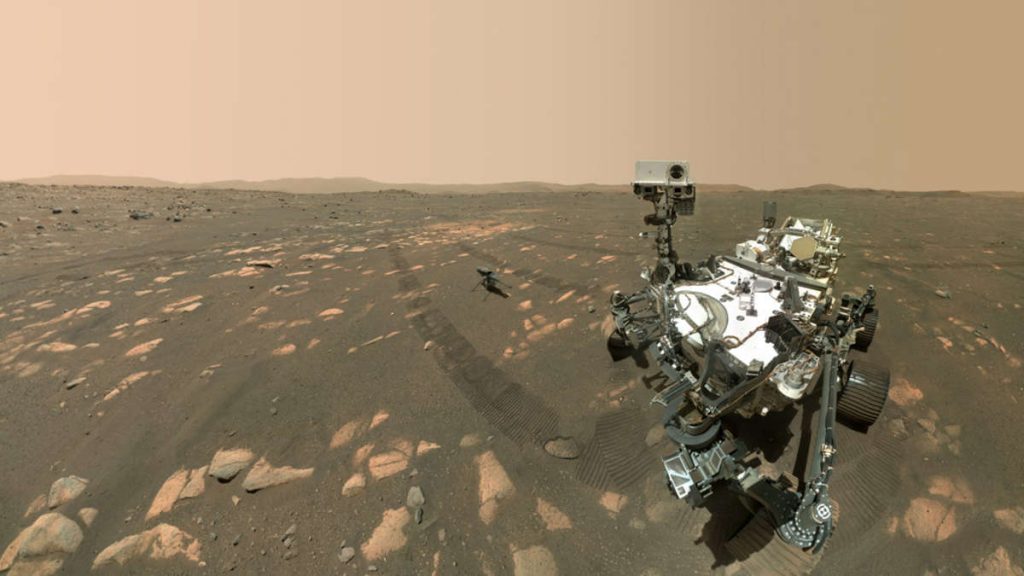-
fromTanya Banner
Close
NASA’s “Perseverance” rover is exploring Mars — and it’s asking an important question soon after it arrives. He didn’t even have to drive for it.
Frankfurt/Pasadena – NASA’s “Persevering” rover faces major missions on Mars. Among other things, he must search for signs of early microbial life on the Red Planet and research the geology and past climate of Mars. The rover has already answered an important question with the first images it has sent back to Earth, NASA has now announced. Recordings and accompanying study have been published in science magazine.
“This is the main observation that assures us once and for all that there was a lake and river delta in Jezero crater,” said scientist Nicholas Mangold, the study’s lead author, in a message from NASA. Today, Jezero crater, where Perseverance landed in February 2021, is completely dry. But once the water was there, experts deduced from the Martian rover’s recordings. So Jezero crater 3.7 billion years ago was a lake fed by a small river.
NASA spacecraft revealed that Jezero Crater on Mars was once a lake connected to a river
The recordings also show experts that there must have been heavy flooding in the lake. According to researchers who worked with Mangold on their study, these floods carried large stones for kilometers along the river and deposited them in the lake where they are still found today.
NASA’s ‘Persevere’ rover: No accidental disclosure
It is no coincidence that “perseverance” hits the bull’s-eye shortly after its arrival. The landing site at Jezero crater was chosen by NASA experts on suspicion that water once flowed there. Recordings from Martian orbits previously showed that Jezero crater looks like a dry lake connected to a river delta. “The rover has solved one of the greatest mysteries without going anywhere,” said cheerful planetary scientist Benjamin Weiss. “Until we got there, the question was always: Was the crater ever a lake?”
Mars experts believe that water on the surface of the Red Planet once existed, but it dried up about 3.5 billion years ago. At that time, according to the current state of research, Mars lost its magnetic field and gradually lost its atmosphere. Another theory suggests that Mars was too small to hold water permanently.
This is what Jezero crater looks like on Mars today. NASA’s “Perseverance” spacecraft has landed in the dry lake.
© NASA/JPL
NASA’s plan: Rover “perseverance” is to visit the former river delta
Meanwhile, the Perseverance rover has covered about 2.6 kilometers into Jezero crater, and if all goes according to plan, you’ll also see the rocks it picked up from a distance to solve the mystery of the lake up close. The rover is scheduled to head to the former river delta to take soil samples there.
Experts believe that sediment from the former lake may contain traces of previous life in the water. Therefore, the “perseverance” must also collect such samples. “Now we have the opportunity to look for fossils,” explains Tanya Bosak of the Massachusetts Institute of Technology.
You imagine Jezero crater on Mars as researched according to the latest discoveries.
© Nasa / JPL-Caltech / MSSS / LPG
Soil samples collected by Perseverance will be stored by the rover on Mars, and a future mission will return samples from Mars to Earth, where they can be directly examined by scientists. “It will take some time to get the stones in which we hope to find traces of life. It is a marathon with great potential,” Boussac continued.
NASA’s “Perseverance” rover: Soil samples will be sent from Mars to Earth
Until then, however, the research must rely on “perseverance” and NASA’s older rover Curiosity, which is conducting research in a different region on Mars. “A better understanding of Jezero crater is key to understanding the changing hydrology in the area,” perseverance scientist Sanjeev Gupta said in a NASA statement. “This could give valuable information on why the entire planet is drying up.”
All important news You will receive astronomy and space travel through our newsletter Directly to your mailbox.
Weiss also has another hope: It is possible that we will find the time in the rock when the crater “passed from a habitable Earth-like environment to this devastated wasteland,” he explains. These beds of ruins can serve as recordings of this transition. We haven’t seen that elsewhere on Mars. (tab)





More Stories
Nvidia GeForce RTX 4090: AIDA64 gets Ada spearhead support
Rogue Trader – Details about the first cRPG in the series – CD-Action
t3n – Digital Pioneers | digital business magazine